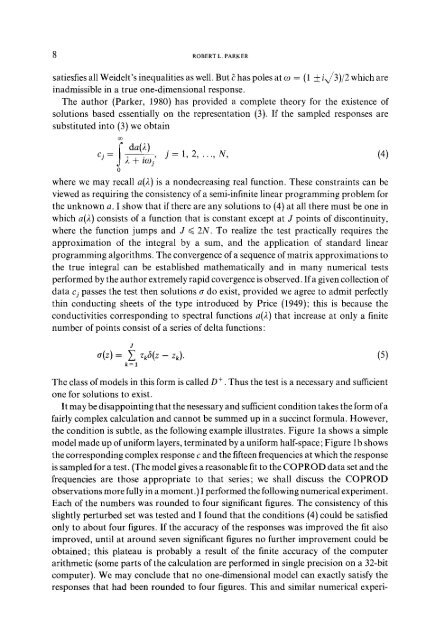R.L. Parker, The magnetotelluric inverse problem - MTNet
R.L. Parker, The magnetotelluric inverse problem - MTNet
R.L. Parker, The magnetotelluric inverse problem - MTNet
You also want an ePaper? Increase the reach of your titles
YUMPU automatically turns print PDFs into web optimized ePapers that Google loves.
8 ROBERT L. PARKER<br />
satiesfies all Weidelt's inequalities as well. But ~ has poles at co = (1 ix/3)/2 which are<br />
inadmissible in a true one-dimensional response.<br />
<strong>The</strong> author (<strong>Parker</strong>, 1980) has provided a complete theory for the existence of<br />
solutions based essentially on the representation (3). If the sampled responses are<br />
substituted into (3) we obtain<br />
f da(2)<br />
c j= 2+icoj' j=l'2 ..... N, (4)<br />
0<br />
where we may recall a(2) is a nondecreasing real function. <strong>The</strong>se constraints can be<br />
viewed as requiring the consistency of a semi-infinite linear programming <strong>problem</strong> for<br />
the unknown a. I show that if there are any solutions to (4) at all there must be one in<br />
which a(2) consists of a function that is constant except at J points of discontinuity,<br />
where the function jumps and J ~< 2N. To realize the test practically requires the<br />
approximation of the integral by a sum, and the application of standard linear<br />
programming algorithms. <strong>The</strong> convergence of a sequence of matrix approximations to<br />
the true integral can be established mathematically and in many numerical tests<br />
performed by the author extremely rapid covergence is observed. If a given collection of<br />
data cj passes the test then solutions ~ do exist, provided we agree to admit perfectly<br />
thin conducting sheets of the type introduced by Price (1949); this is because the<br />
conductivities corresponding to spectral functions a(2) that increase at only a finite<br />
number of points consist of a series of delta functions:<br />
J<br />
o(z)= Z (5)<br />
k=l<br />
<strong>The</strong> class of models in this form is called D +. Thus the test is a necessary and sufficient<br />
one for solutions to exist.<br />
It may be disappointing that the nesessary an d sufficient condition takes the form of a<br />
fairly complex calculation and cannot be summed up in a succinct formula. However,<br />
the condition is subtle, as the following example illustrates. Figure la shows a simple<br />
model made up of uniform layers, terminated by a uniform half-space; Figure lb shows<br />
the corresponding complex response c and the fifteen frequencies at which the response<br />
is sampled for a test. (<strong>The</strong> model gives a reasonable fit to the COPROD data set and the<br />
frequencies are those appropriate to that series; we shall discuss the COPROD<br />
observations more fully in a moment.) I performed the following numerical experiment.<br />
Each of the numbers was rounded to four significant figures. <strong>The</strong> consistency of this<br />
slightly perturbed set was tested and I found that the conditions (4) could be satisfied<br />
only to about four figures. If the accuracy of the responses was improved the fit also<br />
improved, until at around seven significant figures no further improvement could be<br />
obtained; this plateau is probably a result of the finite accuracy of the computer<br />
arithmetic (some parts of the calculation are performed in single precision on a 32-bit<br />
computer). We may conclude that no one-dimensional model can exactly satisfy the<br />
responses that had been rounded to four figures. This and similar numerical experi-
















